|
|
|
|
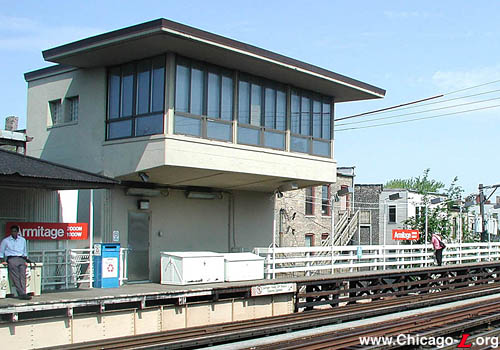 The old Armitage Tower, used to control Armitage Interlocking from 1943 to 1968, is seen looking northwest on June 17, 2003. For a larger view, click here. (Photo by Graham Garfield} |
|
|
|
|
 The old Armitage Tower, used to control Armitage Interlocking from 1943 to 1968, is seen looking northwest on June 17, 2003. For a larger view, click here. (Photo by Graham Garfield} |
Armitage
Tower
Armitage Street and
Sheffield Avenue, Lincoln Park
Service Notes:
Services:
Red Line: Howard
Brown Line: Ravenswood
Purple Line: Evanston Express
Quick Facts:
Established: October 17, 1943
Original Line: North Side Division
Rebuilt: 1995-98
Status: In Use
Profile:
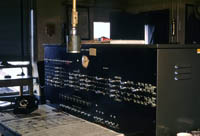
The tower panel inside old Armitage Tower is seen on July 21, 1951. Note that Webster station is still on the panel, though it has been closed for nearly two years. With all the traffic Armitage Tower handled, it's hard to believe the towerman would've had time to read the newspaper. For a larger view, click here. (Photo by B.L. Stone, courtesy of the Krambles-Peterson Archive) |
Tower and its associated interlocking were installed in the early 1940s as part of the construction of the State Street Subway. The subway ascended to the surface at Wisconsin Avenue and joined the North Side Main Line just south of Armitage station. To accommodate the new subway, which came up in the middle of the North Side Main Line's four tracks, the main line had to be widened to allow the four elevated tracks to continue past the subway portal uninterrupted, essentially creating a right-of-way six tracks wide. A set of interlocked switches were installed to not only switch trains between the local and express tracks but between the express elevated tracks and the subway (which was exclusively used by express trains when it opened).
An interlocking tower made of cast concrete was erected at the north end of the Armitage station southbound platform to control the new interlocking. The tower is roughly four stories high, stretching from street level to a control room cantilevered over the tracks. Access is provided to the tower building from both street-level and platform-level. The tower room on the top floor features large picture windows on three sides for visibility north and south down the tracks. The interlocking consisted of a set of universal crossovers (a pair of left- and right-hand crossovers) between Tracks 1 and 2 and between Tracks 3 and 4 a block north of Armitage at Dickens Avenue; a diamond crossover between Tracks 2 and 3 at Armitage; and a left-hand crossover between subway Track A and Track 3 and a right-hand crossover between Track 2 and subway Track B south of Armitage, just before the descent into the subway.
After the CTA's North-South service revision, effective August 1, 1949, only Ravenswood and North Shore Line trains were regularly using the North Side Main Line between the Loop and Armitage, with Evanston Express trains added during weekday rush hours. With far fewer trains using this section of track, all trains used Tracks 2 & 3 between Armitage and Chicago towers during non-rush periods. Effective on the same date, Ravenswood trains operated in service only as far south at Fullerton during evenings and overnight, turning from south back north at Armitage Interlocking. On May 18, 1952, Ravenswood service was discontinued south of Fullerton all day Sundays as well, with the turnback performed at Armitage on Sundays as well. This continued until October 29, 1961 when owl and Sunday Ravenswood trains were cut back from Fullerton to Belmont.
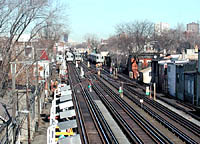 Armitage Interlocking is seen looking north from the old Armitage Tower on December 28, 2001. The number of trains that traverse the North Side Main Line is evident in this view. For a larger view, click here. (Photo by Graham Garfield} |
In the meantime, with the switches converted the manual operation and no need for a tower at Armitage, the old interlocking tower was converted to CTA offices. For many years, the old Armitage Tower housed the North Section district offices where the transportation superintendents had their offices and rail supervisors reported for the North Side "L" routes. In later years, after the districts were dissolved and transportation managers moved to terminals, the old tower became home to the CTA Signal Department.
Armitage Crossover remained the same for nearly 30 years until, in the mid-1990s, work began to renew the switches and covert the Armitage back into an interlocking. On April 4, 1997, the diamond crossover between Tracks 2 and 3 was permanently removed from service. Ten days later, on April 14, 1997, a new diamond crossover between Tracks 2 and 3 a block north of Armitage, at Dickens Avenue, was placed in service. On the same date, a left-hand crossover from Track 1 to Track 2 and a right-hand crossover from Track 3 to Track 4 were placed in service two blocks north of Armitage at Webster Avenue. On July 1, 1998, a new right-hand crossover from Track 1 to Track 2 was placed in service at at Armitage, replacing the old right-hand crossover at Dickens. A similar left-hand crossover at Armitage was also placed ins service between Tracks 3 and 4 around the same time. All of the new crossovers were hand-throw switches for a few years until the new State Street Subway ATC signal system was nearly complete. On May 7, 2001, the new Armitage Interlocking was placed in service, consisting of the above-described two right-hand crossovers, two left-hand crossovers, and one diamond crossover. The new interlocking was not controlled from the old Armitage Tower. Instead, local control was from a relay house located at Webster Avenue.
Brown Line Capacity Expansion Project
As part of the Brown Line Capacity Expansion Project, whose primary purpose was to renovate 16 Brown Line stations to accommodate 8-car trains and provide ADA-accessibility, the signal system on parts of the Brown Line were planned to be upgraded and modernized.
On October 14, 2004, the Chicago Transit Board approved a $45.5 million construction contract for Aldridge -- Mass, AJV (A Joint Venture) to upgrade the signal system. Part of Aldridge's contract was to install a new signal system from Armitage on the south to Addison (North Side Main Line) and Lakewood (Ravenswood branch) on the north. The work on this stretch, which became known as the "Clark Junction Corridor" or simply "the Corridor" during the project, included the installation of 14 new interlocked crossovers at five locations -- Belden, Altgeld, Barry, Clark Junction, and Lakewood-Seminary -- new signals, relay houses, and local control panels, and the rehabilitation of Clark Tower. Work in the Clark Junction Corridor began in late 2004.
Because Armitage Interlocking had only recently been rebuilt, reconstruction of Armitage was not included in the Brown Line signal contract. However, as part of the rehabilitation of Clark Tower, the tower's new master panel has the ability to remotely control all of the interlockings in the Clark Junction Corridor, including Armitage Interlocking. Work at Clark Tower concluded in late 2006.
Funding for the contract was provided by the Federal Transit Administration -- both Full Funding Grant Agreement funds and formula funds -- the Regional Transportation Authority and the Illinois Department of Transportation.
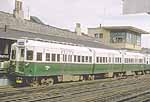 |
cta53c.jpg
(127k) |
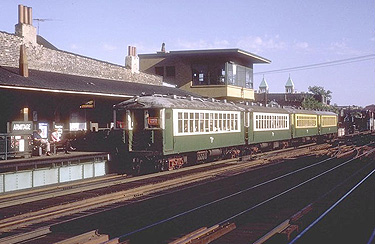 |
armitage01.jpg
(50k) |
 |
armitage02.jpg
(133k) |
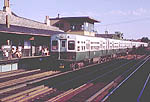 |
cta6158.jpg
(118k) |
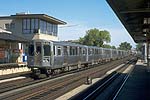 |
cta2611b.jpg
(100k) |
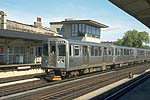 |
cta2829.jpg
(102k) |
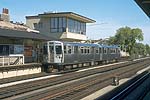 |
cta3324.jpg
(123k) |
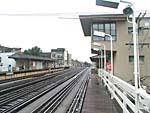 |
armitage03.jpg
(187k) |
 |
armitage04.jpg
(177k) |
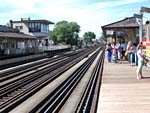 |
armitage15.jpg
(212k) |
|
|